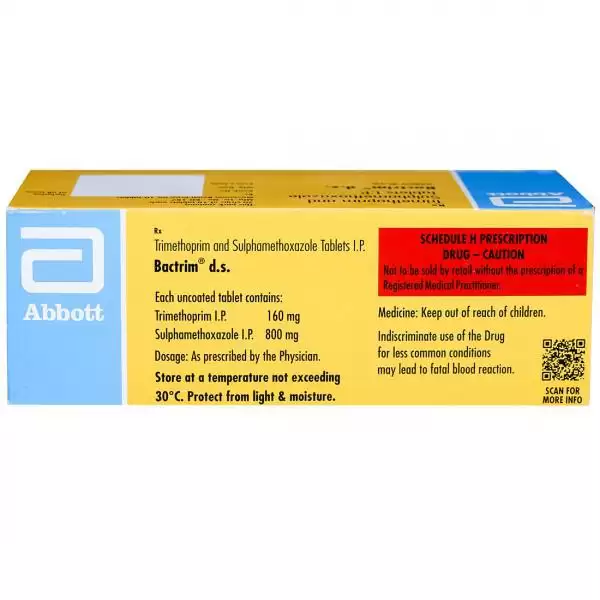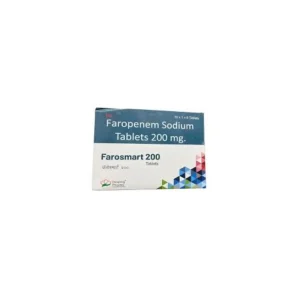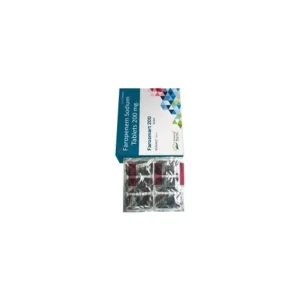Bactrim DS
Bactrim DS is a prescription antibiotic combining sulfamethoxazole and trimethoprim, commonly used to treat various bacterial infections. The “DS” stands for “double strength,” indicating the higher dosage compared to standard formulations.
Bactrim DS Tablet is used to treat bacterial infections of the urinary tract, respiratory tract (bronchitis), ear (otitis media), lungs (pneumonia), skin, brain and toxoplasmosis (infection caused by a bacteria called toxoplasma). Bacterial infections are caused by the multiplication of harmful bacteria inside or on the body. Bactrim DS Tablet does not work against infections caused by the virus, including cold and flu.
Bactrim DS Tablet combines two antibiotics: Trimethoprim (folic acid inhibitors) and Sulfamethoxazole (sulfonamides). Trimethoprim prevents the formation of tetrahydrofolic acid, and sulfamethoxazole stops the bacteria from making dihydrofolic acid. Tetrahydrofolic acid and dihydrofolic acid are essential for forming proteins and nucleic acids, which are necessary for the survival of the bacteria. By inhibiting these, Bactrim DS Tablet stops the growth of bacteria and kills them. Therefore, it helps treat bacterial infections.
Your doctor will decide the dose and duration of Bactrim DS Tablet based on your condition and the severity of the infection. In some cases, you may experience specific common side effects, such as high levels of potassium in the blood, palpitations (abnormal heartbeats), thrush or candidiasis (fungal infection), headache, nausea, diarrhoea, and skin rashes. Most of these side effects do not require medical attention and resolve gradually over time. However, you are advised to talk to your doctor if you experience these side effects persistently.
Before starting Bactrim DS Tablet , please inform your doctor if you have any allergy (against any antibiotic), kidney or liver problems. Do not take Bactrim DS Tablet on your own as self-medication may lead to antibiotic resistance in which antibiotics fail to act against specific bacterial infections. Consult your doctor before taking Bactrim DS Tablet if you are pregnant or breastfeeding. Avoid alcohol consumption to prevent unpleasant side effects such as fast heartbeats, warmth or redness under your skin, tingly feeling, nausea, and vomiting. Bactrim DS Tablet is not recommended for children below 12 years.
Side Effects of Bactrim DS Tablet
- High levels of potassium in the blood
- Palpitations (abnormal heartbeats)
- Thrush or candidiasis (fungal infection)
- Headache
- Nausea
- Diarrhoea
- Skin rashes
Uses of Bactrim DS Tablet
Bactrim DS Tablet is used to treat bacterial infections. The detailed uses of Bactrim DS Tablet are as follows:
- Urinary Tract Infections (UTIs): Bactrim DS Tablet is often utilised to treat urinary tract infections caused by susceptible bacteria. It prevents bacterial growth and allows the immune system to eliminate the disease.
- Respiratory Tract Infection: Bactrim DS Tablet can be used to treat specific respiratory infections, including bronchitis and pneumonia, and prevent breathing difficulties caused by bacterial infection.
- Gastrointestinal infections: Bactrim DS Tablet is often helpful against gastrointestinal infections, especially those caused by Shigella or Salmonella strains. It reduces symptoms like diarrhoea and abdominal pain.
- Skin and Soft Tissue Infections: Bactrim DS Tablet effectively treats bacterial skin infections such as infected cuts, burns, or surgical wounds.
- Pneumocystis Pneumonia (PCP): Bactrim DS Tablet prevents a potentially life-threatening condition in those with weakened immune systems.
Directions for Use
• Bactrim DS Tablet can be taken with or without food as advised by your doctor. • Follow your doctor’s instructions on the dosage and timing of this medication. • Swallow Bactrim DS Tablet as a whole with a glass of water. • Do not crush, break, or chew it.
Medicinal Benefits
Bactrim DS Tablet belongs to the group of medicines called ‘antibiotics’ used to treat various bacterial infections of the urinary tract, respiratory tract (bronchitis), ear (otitis media), lungs (pneumonia), skin, brain and toxoplasmosis (infection caused by a bacteria called toxoplasma). Bactrim DS Tablet is a combination of two antibiotics: Trimethoprim (folic acid inhibitors) and Sulfamethoxazole (sulfonamides). Trimethoprim prevents the formation of tetrahydrofolic acid, and sulfamethoxazole stops the bacteria from making dihydrofolic acid. Tetrahydrofolic acid and dihydrofolic acid are essential for the formation of proteins and nucleic acids, which are necessary for the survival of the bacteria. By inhibiting these, Bactrim DS Tablet kills the bacteria and stops their growth. Therefore, it helps treat bacterial infections. Bactrim DS Tablet is a broad-spectrum antibiotic which is active against a wide range of gram-positive and gram-negative bacteria such as Streptococcus pneumonia, Escherichia coli, Klebsiella species, Enterobacter species, Haemophilus influenzae, etc.
How Bactrim DS Tablet Works
Storage
What if I have taken an overdose of Bactrim DS Tablet
Drug Warnings
Do not take Bactrim DS Tablet if you are allergic to any of its contents; if you have severe liver or kidney problems, thrombocytopenia (low levels of platelets in the blood), or porphyria (rare blood problem). Consult your doctor immediately if you experience skin rash or prolonged, significant diarrhoea with abdominal pain. Talk to your doctor before taking Bactrim DS Tablet if you have severe allergies, asthma, ulcers, blood disorders, thyroid dysfunction, diabetes, are elderly, underweight or malnourished; if you have a folic acid deficiency, glucose-6-phosphate dehydrogenase deficiency, or high levels of potassium in the blood. Consult your doctor if you are pregnant or breastfeeding. Avoid alcohol consumption while taking Bactrim DS Tablet to prevent unpleasant side-effects such as fast heartbeats, warmth or redness under your skin, tingly feeling, nausea, and vomiting.
| Quantity | 30 Tablets, 50 Tablets, 100 Tablets, 200 Tablets, 300 Tablets |
|---|




Reviews
There are no reviews yet.